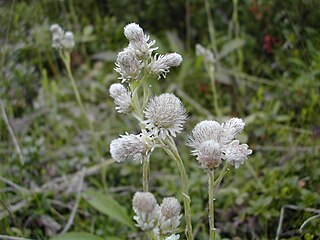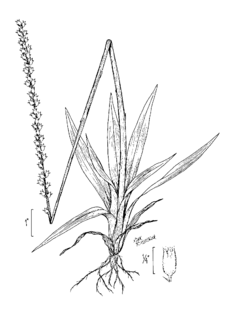
Antennaria is a genus of dioecious perennial herbs in the family Asteraceae, native to temperate regions of the Northern Hemisphere, with a few species in temperate southern South America; the highest species diversity is in North America. Common names include catsfoot or cat's-foot, pussytoes and everlasting.

Antennaria alpina is a European and North American species of plant in the family Asteraceae. Antennaria alpina is native to mountainous and subarctic regions of Scandinavia, Greenland, Alaska, and the Canadian Arctic, extending south at high altitudes in mountains in the Rocky Mountains south to Montana and Wyoming.

NatureServe, Inc. is a non-profit organization based in Arlington County, Virginia, US that provides proprietary wildlife conservation-related data, tools, and services to private and government clients, partner organizations, and the public. NatureServe reports being "headquartered in Arlington, Virginia, with regional offices in four U.S. locations and in Canada." In calendar year 2011 they reported having 86 employees, 6 volunteers, and 15 independent officers.
Antennaria argentea is a North American species of flowering plants in the family Asteraceae known by the common name silver pussytoes or silvery everlasting. It is native primarily to Oregon and to northern and central California with additional populations in Nevada, Idaho, Montana, and Washington.

Antennaria corymbosa is a North American species of flowering plants in the family Asteraceae known by the common names flat-top pussytoes or meadow pussytoes. It is native to western Canada and the Western United States south as far as Tulare County in California and Rio Arriba County in New Mexico. It grows in moist, cool areas such as mountain meadows and riverbanks. Most of the populations are found in the Rocky Mountains, the Cascades, and the Sierra Nevada.

Antennaria rosea is a North American species of flowering plant in the family Asteraceae known by the common name rosy pussytoes. Other common names include cat's foot and mountain everlasting. It is widespread across much of Canada including all three Arctic territories, as well as Greenland, the western and north-central United States, and the Mexican state of Baja California.

Cirsium eatonii, commonly known as Eaton's thistle or mountaintop thistle, is a North American species of flowering plants in the family Asteraceae.

Symphyotrichum lanceolatum is a species of flowering plant in the family Asteraceae native to North America. Common names include panicled aster, lance-leaved aster, and white panicled aster. It is a perennial, herbaceous plant that may reach 1.5 meters tall or more, sometimes approaching 2 meters. The lance-shaped leaves are generally hairless but may feel slightly rough to the touch on the top because of tiny bristles. The flowers grow in clusters and branch in panicles. They have 16–50 white ray florets that are up to 14 millimeters long and sometimes tinged pink or purple. The flower centers consist of disk florets that begin as yellow and become purple as they mature.

Allium simillimum, the Simil Onion, or dwarf onion, is a plant species native to Idaho and Montana. It grows on sandy soils at high elevations in the mountains, 1800–3400 m.

Symphyotrichum oolentangiense, commonly known as skyblue aster and azure aster, is a species of flowering plant in the family Asteraceae native to eastern North America.

Aletris aurea is a plant species native to the southeastern United States from eastern Texas and southeastern Oklahoma to Maryland.

Antennaria anaphaloides, the pearly pussytoes, is a North American species of plants in the family Asteraceae. It is native to western Canada and the western United States.
Antennaria arcuata, the box pussytoes, is a North American species of plants in the family Asteraceae. It grows in the western part of the United States, in the States of Idaho, Wyoming, and Nevada.
Antennaria aromatica, the scented pussytoes, is a North American species of plants in the family Asteraceae. It is native to the Rocky Mountains of Alberta, Montana, Idaho, and Wyoming. The crushed foliage has a strong scent resembling that of citronella.
Antennaria friesiana, or Fries' pussytoes, is an Arctic species of plants in the family Asteraceae. It is the northern reaches of Asia and North America. Many of the populations lack male (staminate) flowers and reproduce asexually.

Plagiomnium venustum, also known as magnificent leafy moss, is a species of moss belonging to the family Mniaceae. It is found mainly in western North America along the coastal region. This moss can be identified from other members of the Plagiomnium genus by dark coloured stomata guide cells and the absence of sterile stems. It is most commonly found growing as a mat on a variety of substrate, but mainly on humus and moist soil.
Montia bostockii, known by the common name Bostock's minerslettuce, is a species in the genus Montia found in Alaska and northwestern Canada.

Symphyotrichum molle is a species of flowering plant in the aster family (Asteraceae) endemic to the Bighorn Mountains of Montana and Wyoming in the United States. Commonly known as soft aster, it is a perennial, herbaceous plant that ranges from 30 to 60 centimeters in height.

Sphagnum contortum is a species of moss reported in North America and Europe. NatureServe marked its global conservation status as Secure.














